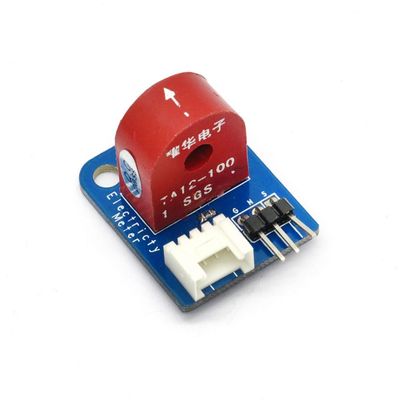Difference between revisions of "Electricity Meter(Analog)"
(→Demo) |
(→Download) |
||
| Line 99: | Line 99: | ||
==Download== | ==Download== | ||
| + | [ftp://imall.iteadstudio.com/Electronic_Brick/IM120710018/DS_IM120710018.pdf Datasheet for Electricity Meter(Analog)] | ||
| + | |||
| + | [ftp://imall.iteadstudio.com/Electronic_Brick/IM120710018/SCH_IM120710018.pdf Schematic for Electricity Meter(Analog)] | ||
| + | |||
| + | [ftp://imall.iteadstudio.com/Electronic_Brick/IM120710018/DEMO_IM120710018.zip Demo code for Electricity Meter(Analog)] | ||
==Useful Links== | ==Useful Links== | ||
Revision as of 05:53, 27 May 2014
Contents
Overview
Electronic brick of electricity sensor is based on TA12-100 current transformer, which can transform AC signals of large current into small amplitude signals. The maximum current that can be detected can reach 5A, and the present current signal can be read via analog I / O port.
Features
1. Plug and play, easy to use. Compatible with the mainstream 2.54 interfaces and 4-Pin Grove interfaces in the market.

2. With use of M4 standard fixed holes, compatible with M4-standard kits such as Lego and Makeblock.

Specifications
| PCB size | 30.0mm X 24.0mm X 1.6mm |
| Compatible interfaces | 2.54 3-pin interface and 4-pin Grove interface(1) |
Note 1: S for analog output port, G for ground, and N for not used pin.
Electrical Characteristics
| Parameter | Min. | Typical | Max. | Unit |
| Transformation coefficient | - | 1000:01:00 | - | - |
| Input current | 0 | - | 5 | A |
| Output current | 0 | - | 5 | mA |
| Sampling resistor | - | 200 | - | Ω |
| Sampling voltage | 0 | - | 1 | V |
| Working frequency | 20 | - | 20000 | Hz |
| Working temperature | -55 | - | 85 | ℃ |
| Dielectric strength | - | 6 | - | KAC/1min |
Demo
Connect S port of electronic brick of electricity sensor to A0 port of Arduino board, and we will use the following program to read the analog value, and the send it to computer for display via serial port.
#define ELECTRICITY_SENSOR A0 // Analog input pin that sensor is attached to
float amplitude_current; //amplitude current
float effective_value; //effective current
void setup()
{
Serial.begin(9600);
pins_init();
}
void loop()
{
int sensor_max;
sensor_max = getMaxValue();
Serial.print("sensor_max = ");
Serial.println(sensor_max);
//the VCC on the Grove interface of the sensor is 5v
amplitude_current=(float)sensor_max/1024*5/200*1000000;
effective_value=amplitude_current/1.414;
//minimum_current=1/1024*5/200*1000000/1.414=24.4(mA)
//Only for sinusoidal alternating current
Serial.println("The amplitude of the current is(in mA)");
Serial.println(amplitude_current,1);//Only one number after the decimal point
Serial.println("The effective value of the current is(in mA)");
Serial.println(effective_value,1);
}
void pins_init()
{
pinMode(ELECTRICITY_SENSOR, INPUT);
}
/*Function: Sample for 1000ms and get the maximum value from the SIG pin*/
int getMaxValue()
{
int sensorValue; //value read from the sensor
int sensorMax = 0;
uint32_t start_time = millis();
while((millis()-start_time) < 1000)//sample for 1000ms
{
sensorValue = analogRead(ELECTRICITY_SENSOR);
if (sensorValue > sensorMax)
{
/*record the maximum sensor value*/
sensorMax = sensorValue;
}
}
return sensorMax;
}
Download
Datasheet for Electricity Meter(Analog)
Schematic for Electricity Meter(Analog)
Demo code for Electricity Meter(Analog)
 Notice
Notice